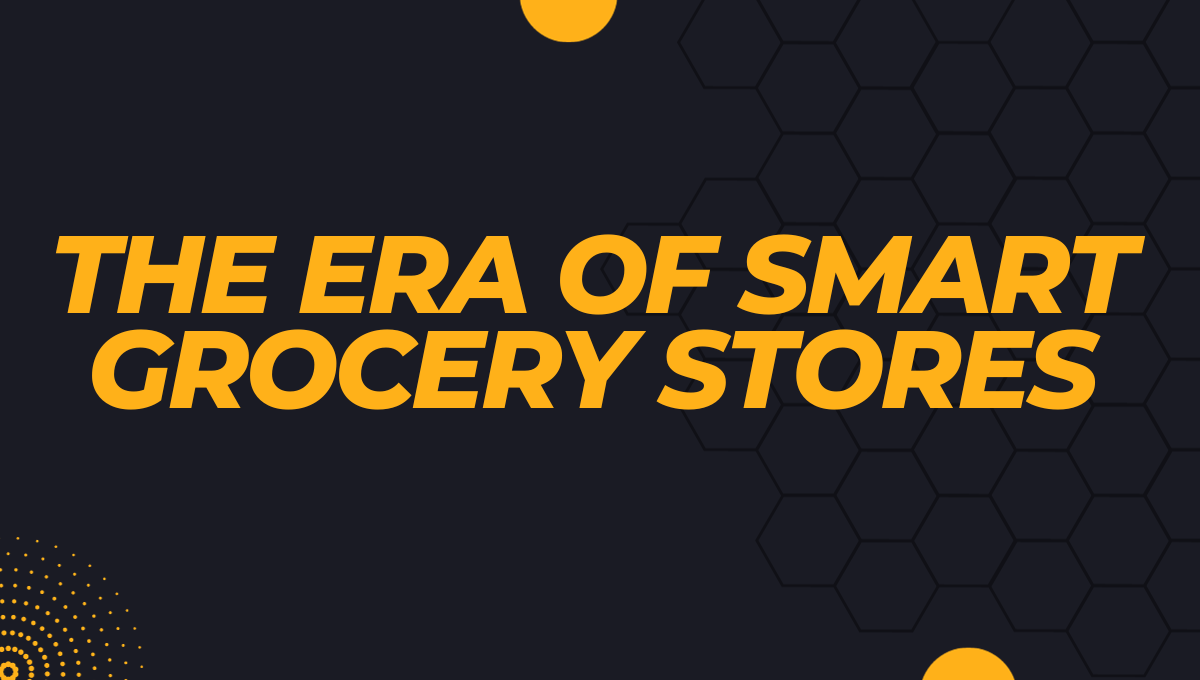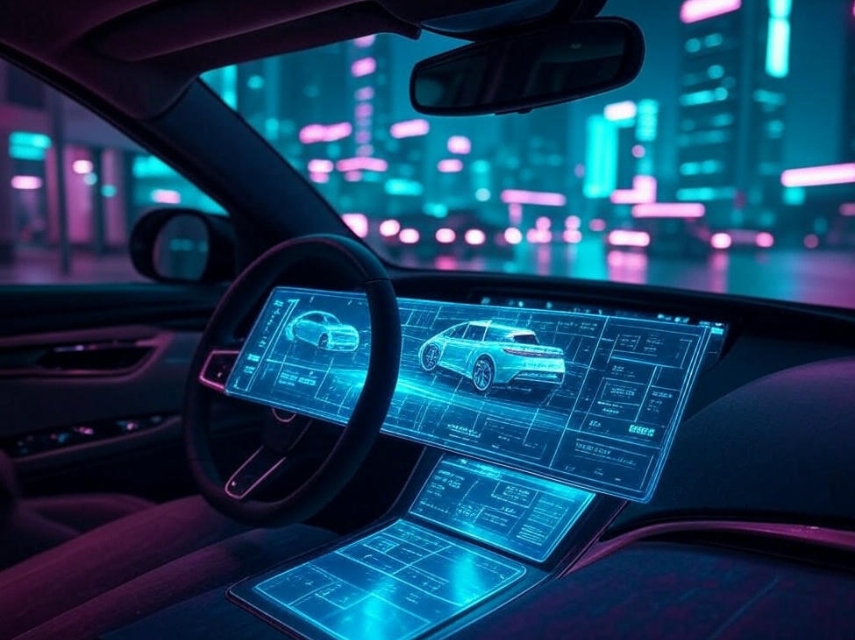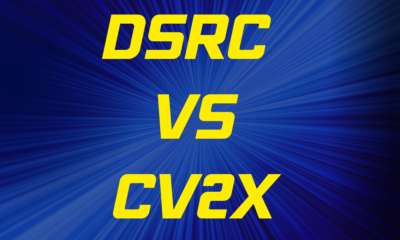Tech
Effortless Shopping: The Era of Smart Grocery Stores
Welcome to the future of grocery shopping! Gone are the days of wandering aimlessly through crowded aisles, juggling a basket overflowing with items, and waiting impatiently in long checkout lines. The era of smart grocery stores has arrived, ushering in an era of effortless shopping like never before. Imagine a world where your groceries magically appear at your doorstep or simply require a quick tap on your smartphone. Get ready to embark on a journey into this revolutionized shopping experience that promises convenience, efficiency, and innovation at every turn. So grab your virtual cart and let’s explore how technology is transforming the way we fill our pantries in ways we never thought possible!
Published
2 years agoon
By
Adva
In a world where technology is advancing at an unprecedented pace, it comes as no surprise that traditional grocery stores are evolving into something extraordinary. Welcome to the era of the smart supermarket. These innovative stores are redefining the way we shop for groceries, offering convenience, efficiency, and a glimpse into the future. In this article, we will delve into the concept of smart grocery stores, emphasizing the revolutionary concept of cashier-less checkout.
The Rise of Smart Grocery Stores
Smart grocery stores, often referred to as the “smart supermarket,” are at the forefront of retail innovation. These stores leverage cutting-edge technologies to create an enhanced shopping experience that caters to the needs and preferences of today’s tech-savvy consumers. Several key technologies and features set smart grocery stores apart:
Automated Checkout Systems:
At the heart of the smart supermarket is the concept of cashier-less checkout (also involved: AI checkout systems). Advanced computer vision, machine learning, and sensor technologies are employed to track items as shoppers pick them up and place them in their carts. This eliminates the need for traditional checkout lines and cashiers, significantly reducing waiting times.
Mobile Apps and Self-Checkout Kiosks:
Customers can download dedicated store apps or use self-checkout kiosks to scan and pay for their items as they shop. These apps often offer features like digital shopping lists, personalized recommendations, and real-time promotions.
Artificial Intelligence (AI) and Personalization:
Smart supermarkets employ AI algorithms to analyze customers’ purchase histories and preferences. This enables highly personalized product recommendations and tailored discounts, creating a more engaging shopping experience.
Smart Shelves and Inventory Management:
IoT-enabled smart shelves with RFID tags help maintain accurate inventory levels. When an item is removed from the shelf, the system updates its status in real-time, preventing out-of-stock situations and ensuring a smooth shopping experience.
Contactless Payments:
Smart grocery stores prioritize contactless payment options, such as mobile wallets and NFC-enabled credit cards. These methods enhance convenience and safety, aligning with modern shopping trends.

The Cashier-less Checkout Revolution
The concept of cashier-less checkout is undoubtedly the cornerstone of smart grocery stores. This revolutionary approach transforms the shopping experience in several ways:
Time Efficiency:
One of the most significant advantages of cashier-less checkout is the time saved. Customers can enter, shop, and exit the store without ever waiting in a checkout line. This seamless process enhances efficiency and convenience, making it easier for shoppers to fit grocery runs into their busy schedules.
Reduced Human Error:
Cashier-less checkout minimizes the risk of human error. Pricing discrepancies, incorrect change, and mis-scanned items become a thing of the past. This not only benefits shoppers but also ensures greater accuracy in inventory management.
Enhanced Privacy:
For those who value their privacy, cashier-less checkout offers a discreet shopping experience. There’s no need to engage with cashiers or divulge personal information during the transaction.
Streamlined Store Layout:
Smart supermarkets often feature a more open and inviting layout since there is no need for a dedicated cashier area. This can lead to a more pleasant shopping environment.
Challenges and Considerations
While smart grocery stores offer a host of benefits, there are challenges and considerations to address:
Implementation Costs:
Setting up a smart supermarket with cashier-less checkout requires a substantial initial investment in technology infrastructure. Retailers must weigh these costs against the potential long-term benefits.
Technological Dependence:
The reliance on advanced technology means that stores must be well-equipped and maintain these systems. Any technical glitches or outages could disrupt the shopping experience.
Accessibility and Inclusivity:
Retailers need to ensure that their smart stores remain accessible to all customers, including those who may not be comfortable with or have access to smartphones or the latest technology.
The concept of smart grocery stores, with their cashier-less checkout systems, represents a significant leap forward in the world of retail. These stores are at the forefront of technology, leveraging AI, IoT, and automation to create an efficient, convenient, and personalized shopping experience. While there are challenges to overcome, the advantages for both retailers and consumers are undeniable. The smart supermarket is not just a glimpse into the future; it’s a bold step toward redefining the way we shop for groceries. As these stores continue to evolve and become more widespread, we can expect the grocery shopping experience to become more seamless and enjoyable than ever before.
Questions and Answers
Q1: What security measures are in place to protect customer data in smart supermarkets with cashier-less checkout?
A1: Smart supermarkets prioritize data security through encryption and advanced cybersecurity protocols to safeguard customer payment information and personal data.
Q2: How do smart supermarkets ensure that their inventory is always fresh and not past its expiration date?
A2: Smart supermarkets utilize real-time tracking of product shelf life through RFID tags and sensors, sending alerts to staff when products are nearing their expiration date. This helps maintain the freshness of items on the shelves.
Q3: Are there any plans to expand the concept of smart grocery stores beyond urban areas to benefit rural communities?
A3: Some retailers are indeed exploring the expansion of smart grocery stores to rural areas, aiming to bring the benefits of cashier-less checkout and convenience to a broader range of consumers. These stores would be adapted to suit the specific needs of rural communities, ensuring accessibility for all.
As a freelance tech and startup news writer, I'm always looking to stay up-to-date with the latest in the industry. I have a background in web development and marketing, so I'm particularly interested in how new startups are using technology to change the world.

You may like
Business Solutions
Geneo Glam: Skin Firming Treatment for Radiant, Youthful Skin
Geneo Glam is the ultimate skin firming treatment designed to restore elasticity, enhance radiance, and leave you with a glowing, youthful complexion.
Published
12 hours agoon
May 9, 2025By
Marks Strand
The Geneo Glam skin firming treatment is a luxurious, non-invasive facial that revitalizes the skin by improving firmness, elasticity, and hydration. Using advanced OxyPod technology, this treatment delivers a unique combination of exfoliation, oxygenation, and infusion of active ingredients to help the skin look smoother, tighter, and more radiant.
Key Benefits
- Firms and Hydrates
The treatment boosts collagen and elastin production, helping skin feel firmer and more supple. - Improves Elasticity
Increases the skin’s resilience and reduces the appearance of fine lines and wrinkles. - Prevents Collagen Breakdown
Helps preserve the skin’s youthful structure by protecting existing collagen and supporting healthy cell function.
Powerful Natural Ingredients
- 24K Gold Particles
Stimulate collagen production, protect skin fibers, and encourage cell renewal for a firmer, lifted appearance. - Silk Amino Acids
Strengthen the skin barrier, lock in moisture, and support collagen synthesis to reduce visible signs of aging. - Carnosine Peptides
Help protect the skin from sugar-related damage (glycation), delay cellular aging, and extend the life of skin cells. - Copper
An antioxidant and anti-inflammatory that supports collagen development, smooths fine lines, and helps with skin regeneration.
How the Treatment Works
- Exfoliation and Oxygenation
The Geneo Glam OxyPod is activated with a Primer Gel, gently exfoliating the skin and triggering a natural oxygenation process that increases blood flow and enhances skin vitality. - Infusion of Actives
Active ingredients such as gold particles, peptides, and amino acids are infused deep into the skin to firm and rejuvenate. - Hydration and Nourishment
A final serum containing hyaluronic acid, rosehip oil, and marula oil hydrates and soothes the skin, leaving it soft and glowing.
Who Should Try Geneo Glam?
This treatment is ideal for people who want to:
- Reduce fine lines and early signs of aging
- Firm and tighten sagging skin
- Restore hydration and improve skin tone
Geneo Glam offers a refreshing way to firm, lift, and hydrate your skin—leaving you with a youthful glow and smooth, resilient skin. It’s a perfect solution for anyone seeking visible results without invasive procedures or downtime.
Business Solutions
H.265 miniature UAV encoders: A comprehensive Overview
H.265 miniature UAV encoders revolutionize aerial technology with advanced video compression, ensuring high efficiency and superior performance for modern UAV systems.
Published
2 days agoon
May 8, 2025By
Adva
As the demand for high-quality, real-time video transmission from unmanned aerial vehicles (UAVs) continues to rise in both military and commercial applications, the need for efficient, compact video encoding solutions has become paramount. H.265 miniature UAV encoders represent a significant advancement in this space, providing robust video compression in a small, lightweight package ideal for drones with stringent size, weight, and power (SWaP) constraints. Leveraging the power of High Efficiency Video Coding (HEVC), also known as H.265, these encoders allow UAVs to deliver high-resolution video over constrained data links, enhancing situational awareness and operational effectiveness without overwhelming available bandwidth.
H.265 is a video compression standard that succeeds H.264/AVC and offers approximately double the data compression ratio at the same video quality level. This efficiency is particularly beneficial for UAV applications, where bandwidth and power availability are limited, especially during beyond-line-of-sight (BLOS) missions or in contested environments. With H.265 encoders, UAVs can stream 1080p or even 4K encoder video in real time while consuming significantly less data than older standards. This is critical for operations such as intelligence, surveillance, and reconnaissance (ISR), where maintaining video clarity over long distances or through relay networks is essential for accurate decision-making.
Miniature H.265 UAV encoders are engineered to operate under harsh environmental conditions while maintaining optimal performance. These devices are typically ruggedized, featuring extended temperature ranges, shock resistance, and electromagnetic shielding to ensure reliable operation in military or field environments. Despite their small size—often no larger than a deck of cards—they include advanced features such as low-latency encoding, dynamic bitrate control, encryption, and support for multiple streaming protocols including RTSP, RTP, and MPEG-TS. This allows them to integrate seamlessly into existing command-and-control infrastructure and support a variety of end-user applications, from real-time ground monitoring to autonomous navigation and object tracking.

The integration of H.265 encoders into small UAVs has significantly expanded the capability of tactical drone systems. For example, military units can deploy hand-launched drones equipped with these encoders to provide persistent ISR coverage over a battlefield, transmitting clear, actionable video intelligence back to command centers in near real time. Law enforcement agencies and border security forces also benefit from these technologies, using UAVs to monitor large or remote areas with minimal personnel. In disaster response scenarios, such encoders enable drones to deliver live aerial assessments of affected regions, helping responders prioritize actions and coordinate relief efforts efficiently.
Beyond video transmission, modern H.265 UAV encoders are increasingly integrated with onboard artificial intelligence modules that enable edge processing. This allows UAVs to perform real-time object recognition, motion detection, and scene analysis directly within the encoder, reducing the need to send raw data to centralized systems for processing. Such capabilities are crucial in time-sensitive missions where latency can affect outcomes, such as tracking moving targets or identifying threats in complex terrain.
Despite their many advantages, the deployment of H.265 miniature encoders does come with some technical considerations. The encoding process, while more efficient than previous standards, requires higher computational resources. Manufacturers must therefore strike a careful balance between processing power, thermal management, and energy consumption. Additionally, the compatibility of H.265 streams with legacy systems remains a factor, as not all ground stations or video players natively support HEVC decoding without updates or specialized software.
Manufacturers of H.265 miniature UAV encoders include companies such as IMT Vislink, Soliton Systems, Haivision, and VITEC, all of which provide solutions tailored to UAV and robotics applications. These encoders are often modular, allowing integrators to select configurations based on mission requirements, payload limitations, and transmission needs. As the ecosystem of compact, high-efficiency video systems grows, continued innovation in low-power silicon and AI integration is expected to drive the next wave of capability enhancements in this field.
In the evolving landscape of drone technology, H.265 miniature UAV encoders stand out as a critical enabler of high-performance video transmission. By combining advanced compression with minimal SWaP impact, these systems provide UAV operators with the tools to observe, analyze, and act with unprecedented precision and clarity—no matter how small the platform or how demanding the environment.
Business Solutions
IEEE 802.11p and V2X Communication: Enabling Smarter, Safer Roads
IEEE 802.11p revolutionizes V2X communication, driving smarter, safer roads through advanced vehicle connectivity. This cutting-edge technology enhances transportation systems, enabling intelligent and secure interactions for a safer future.
Published
2 days agoon
May 7, 2025By
Adva
Modern vehicles are no longer isolated machines; they are becoming intelligent, connected nodes within a larger transportation ecosystem. At the heart of this transformation is Vehicle-to-Everything (V2X) communication, which enables cars to talk to each other and to the infrastructure around them. One of the first and most influential technologies developed to support V2X is the IEEE 802.11p standard—a wireless standard specifically tailored for vehicular environments.
What is IEEE 802.11p?
IEEE 802.11p is an amendment to the IEEE 802.11 standard (commonly known as Wi-Fi), designed to enable wireless access in vehicular environments. It was approved in 2010 and forms the basis for Dedicated Short-Range Communications (DSRC).
Key Characteristics of 802.11p:
- Frequency Band: Operates in the 5.9 GHz band reserved for Intelligent Transportation Systems (ITS).
- Low Latency: Optimized for fast, real-time communication necessary for safety-critical applications.
- Range: Effective communication range of up to 1 kilometer, suitable for high-speed vehicle interaction.
- Decentralized Architecture: Enables direct communication (V2V and V2I) without the need for cellular or network infrastructure.
- Robustness: Handles high-speed mobility and rapidly changing topologies typical of vehicular environments.

Role of 802.11p in V2X Communication
V2X (Vehicle-to-Everything) is a broader term encompassing various communication paradigms, including:
- V2V (Vehicle-to-Vehicle)
- V2I (Vehicle-to-Infrastructure)
- V2P (Vehicle-to-Pedestrian)
- V2N (Vehicle-to-Network)
- V2C (Vehicle-to-Cloud)
802.11p primarily supports V2V and V2I communications, forming the backbone of DSRC-based V2X implementations. Its low latency and direct communication capabilities make it ideal for applications such as:
- Forward collision warnings
- Intersection movement assist
- Emergency electronic brake lights
- Lane change warnings
Comparison with Cellular V2X (C-V2X)
As V2X technology has evolved, C-V2X (based on LTE and 5G standards) has emerged as a strong alternative to 802.11p. Here’s how they compare:
| Feature | IEEE 802.11p (DSRC) | C-V2X (LTE/5G) |
| Latency | ~10 ms | ~5–10 ms (LTE), <5 ms (5G) |
| Coverage | Short-range, direct | Short + long-range via network |
| Deployment | Mature, field-tested | Growing, especially with 5G |
| Infrastructure | Minimal (no cellular needed) | Requires cellular networks (for V2N/V2C) |
| Interoperability | Limited with C-V2X | Newer versions support dual-mode |
Adoption and Use Cases
Global Deployment:
- United States: Initially favored DSRC based on 802.11p, though recent FCC rulings have shifted focus toward C-V2X.
- Europe: ETSI has defined ITS-G5, a protocol stack based on 802.11p.
- Japan and South Korea: Active use of DSRC for tolling and traffic safety.
Real-World Applications:
- Collision avoidance systems
- Smart intersections
- Road hazard notifications
- Platooning for commercial vehicles
- Public transport priority systems
Advantages of 802.11p
- Mature and Proven: Used in numerous pilot programs and early deployments.
- Fast Time to Communication: No need for handshake protocols; devices can communicate almost instantly.
- No Subscription Costs: Operates independently of cellular networks.
Limitations and Challenges
- Scalability: In high-density traffic, packet collisions may reduce reliability.
- Spectrum Allocation: Regulatory changes in some countries have limited the bandwidth available to DSRC.
- Limited Ecosystem Growth: Many automakers and countries are shifting investment to C-V2X and 5G-based platforms.
Future Outlook
While 802.11p has laid the foundation for V2X communication, the industry is gradually pivoting toward more advanced and scalable technologies such as 5G NR-V2X. However, 802.11p remains relevant in regions where DSRC infrastructure is already deployed and continues to serve as a dependable option for immediate, low-latency vehicular communication.
Hybrid Solutions:
Some industry players are exploring dual-mode V2X devices that support both 802.11p and C-V2X, ensuring backward compatibility and smoother transitions.
IEEE 802.11p has played a pivotal role in launching the era of connected vehicles, offering reliable, low-latency communication tailored for high-speed mobility. While newer technologies like C-V2X and 5G are beginning to dominate the roadmap, 802.11p’s contributions remain foundational in the evolution of V2X systems. As the automotive industry moves forward, a mix of technologies, including legacy support for 802.11p, will ensure that safety, efficiency, and connectivity continue to advance on roads around the world.

Geneo Glam: Skin Firming Treatment for Radiant, Youthful Skin

H.265 miniature UAV encoders: A comprehensive Overview

IEEE 802.11p and V2X Communication: Enabling Smarter, Safer Roads
Trending
-
Marketing & Analytics2 years ago
A Complete Guide To HubSpot’s New B2B Marketing, Sales Hub, and Prospecting Tool
-
3D Technology2 years ago
3D Scanner Technology for Android Phones: Unleashing New Possibilities
-
Marketing & Analytics2 years ago
How SMS Services And Software For Bulk SMS Sending Can Help Your Business Grow
-
3D Technology2 years ago
Mobile 3D Scanners: Revolutionizing 3D Scanning Technology
-
3D Technology2 years ago
3D scanning technologies and scanning process
-
Business Solutions1 year ago
Understanding A2P Messaging and the Bulk SMS Business Landscape
-

 Business Solutions1 year ago
Business Solutions1 year agoThe Power of Smarts SMS and Single Platform Chat Messaging
-

 Automotive2 years ago
Automotive2 years agoDSRC vs. CV2X: A Comprehensive Comparison of V2X Communication Technologies



